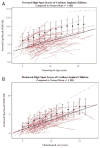Developmental trajectories of forward and backward digit spans in deaf children with cochlear implants
- PMID: 21756483
- PMCID: PMC3304450
- DOI: 10.1179/146701011X13001035752534
Developmental trajectories of forward and backward digit spans in deaf children with cochlear implants
Abstract
Background: Accounting for outcome variability among pediatric cochlear implant (CI) recipients is an enduring clinical challenge. Short-term memory and working memory (STM/WM), as indexed by digit span forward (DSF) and digit span backward (DSB), have been shown to be strongly correlated with speech and language (S/L) outcomes. The enormous variability observed in conventional outcome measures of S/L may reflect individual differences in STM/WM.
Methods: Repeated measure auditory digit spans were obtained from 110 children (age 3-15 years; mean 7.2 years) with at least 2 years of CI use. Growth curves were computed for each child, and linear functions were fit to both DSF and DSB. Slopes and intercepts were used as parameters in mixed-models to assess relations between STM/WM capacity change over time and S/L outcome measures including vocabulary (PPVT), open-set set spoken word recognition (PBK), and sentence perception (HINT-C).
Results: For DSF, the percent of the sample more than 1 SD below the norm at each age ranged from 54 to 90% (mean = 66.5%). For DSB, the percent of the sample more than 1 SD below the norm at each age ranged from 23 to 42% (mean = 34.5%) at ages where there were at least five children. Four subgroups within our CI sample emerged: (Subgroup 1) children demonstrating age-appropriate growth in both DSF and DSB scores over time (49/110, 44.55%); (Subgroup 2) children demonstrating age appropriate growth in DSF over time but below average growth in DSB over time (23/110, 20.91%); (Subgroup 3) children demonstrating below average growth in DSF over time but age-appropriate growth in DSB over time (19/110, 17.27%); and (Subgroup 4) children demonstrating below average growth in both DSF and DSB over time (19/110, 17.27%). For all tests except CELF-3, Subgroup 4 demonstrated the poorest performance among the four DS slope subgroups. Significant differences were observed between Subgroup 1 and Subgroup 4 on last visit PBK-Word (P = 0.029), PPVT (P = 0.018), and HINT-C in Quiet (P = 0.001), but not CELF-3 (P = 0.433).
Conclusion: The findings from this longitudinal study suggest that differences in the rate of development of STM/WM may influence S/L outcomes in children with CIs. The clinical implications of these findings are significant because they indicate that the rate of development of STM/WM, and not just the actual level of STM/WM at a single time point, predicts later S/L development in this clinical population. Targeted interventions to improve developmental rate of verbal STM/WM may hold promise for enhancing S/L skills in children with CIs.
Conflict of interest statement
Figures



Similar articles
-
Verbal short-term memory development and spoken language outcomes in deaf children with cochlear implants.Ear Hear. 2013 Mar-Apr;34(2):179-92. doi: 10.1097/AUD.0b013e318269ce50. Ear Hear. 2013. PMID: 23000801 Free PMC article.
-
Profiles of verbal working memory growth predict speech and language development in children with cochlear implants.J Speech Lang Hear Res. 2013 Jun;56(3):805-25. doi: 10.1044/1092-4388(2012/11-0356). Epub 2012 Dec 28. J Speech Lang Hear Res. 2013. PMID: 23275401 Free PMC article.
-
Measures of digit span and verbal rehearsal speed in deaf children after more than 10 years of cochlear implantation.Ear Hear. 2011 Feb;32(1 Suppl):60S-74S. doi: 10.1097/AUD.0b013e3181ffd58e. Ear Hear. 2011. PMID: 21832890 Free PMC article.
-
Folic acid supplementation and malaria susceptibility and severity among people taking antifolate antimalarial drugs in endemic areas.Cochrane Database Syst Rev. 2022 Feb 1;2(2022):CD014217. doi: 10.1002/14651858.CD014217. Cochrane Database Syst Rev. 2022. PMID: 36321557 Free PMC article.
-
The Role of Statistical Learning in Understanding and Treating Spoken Language Outcomes in Deaf Children With Cochlear Implants.Lang Speech Hear Serv Sch. 2018 Aug 14;49(3S):723-739. doi: 10.1044/2018_LSHSS-STLT1-17-0138. Lang Speech Hear Serv Sch. 2018. PMID: 30120449 Free PMC article. Review.
Cited by
-
The Contribution of Verbal Working Memory to Deaf Children's Oral and Written Production.J Deaf Stud Deaf Educ. 2015 Jul;20(3):203-14. doi: 10.1093/deafed/env005. Epub 2015 Mar 22. J Deaf Stud Deaf Educ. 2015. PMID: 25802319 Free PMC article.
-
The approximate number system and domain-general abilities as predictors of math ability in children with normal hearing and hearing loss.Br J Dev Psychol. 2018 Jun;36(2):236-254. doi: 10.1111/bjdp.12204. Epub 2017 Aug 29. Br J Dev Psychol. 2018. PMID: 28851061 Free PMC article.
-
Neurocognitive function in children with cochlear implants and hearing aids: a systematic review.Front Neurosci. 2023 Oct 4;17:1242949. doi: 10.3389/fnins.2023.1242949. eCollection 2023. Front Neurosci. 2023. PMID: 37859761 Free PMC article.
-
Understanding Theory of Mind in Deaf and Hearing College Students.J Deaf Stud Deaf Educ. 2019 Apr 1;24(2):104-118. doi: 10.1093/deafed/eny039. J Deaf Stud Deaf Educ. 2019. PMID: 30597037 Free PMC article.
-
Early Expressive Language Skills Predict Long-Term Neurocognitive Outcomes in Cochlear Implant Users: Evidence from the MacArthur-Bates Communicative Development Inventories.Am J Speech Lang Pathol. 2016 Aug 1;25(3):381-92. doi: 10.1044/2016_AJSLP-15-0023. Am J Speech Lang Pathol. 2016. PMID: 27390923 Free PMC article.
References
-
- Baddeley A. Working Memory, Thought And Action. Oxford: Oxford University Press; 2007.
-
- Cochlear Implants in Adults and Children. NIH Consens Statement. 1995 May 15–17;13(2):1–30. - PubMed
Publication types
MeSH terms
Grants and funding
LinkOut - more resources
Full Text Sources
Medical
